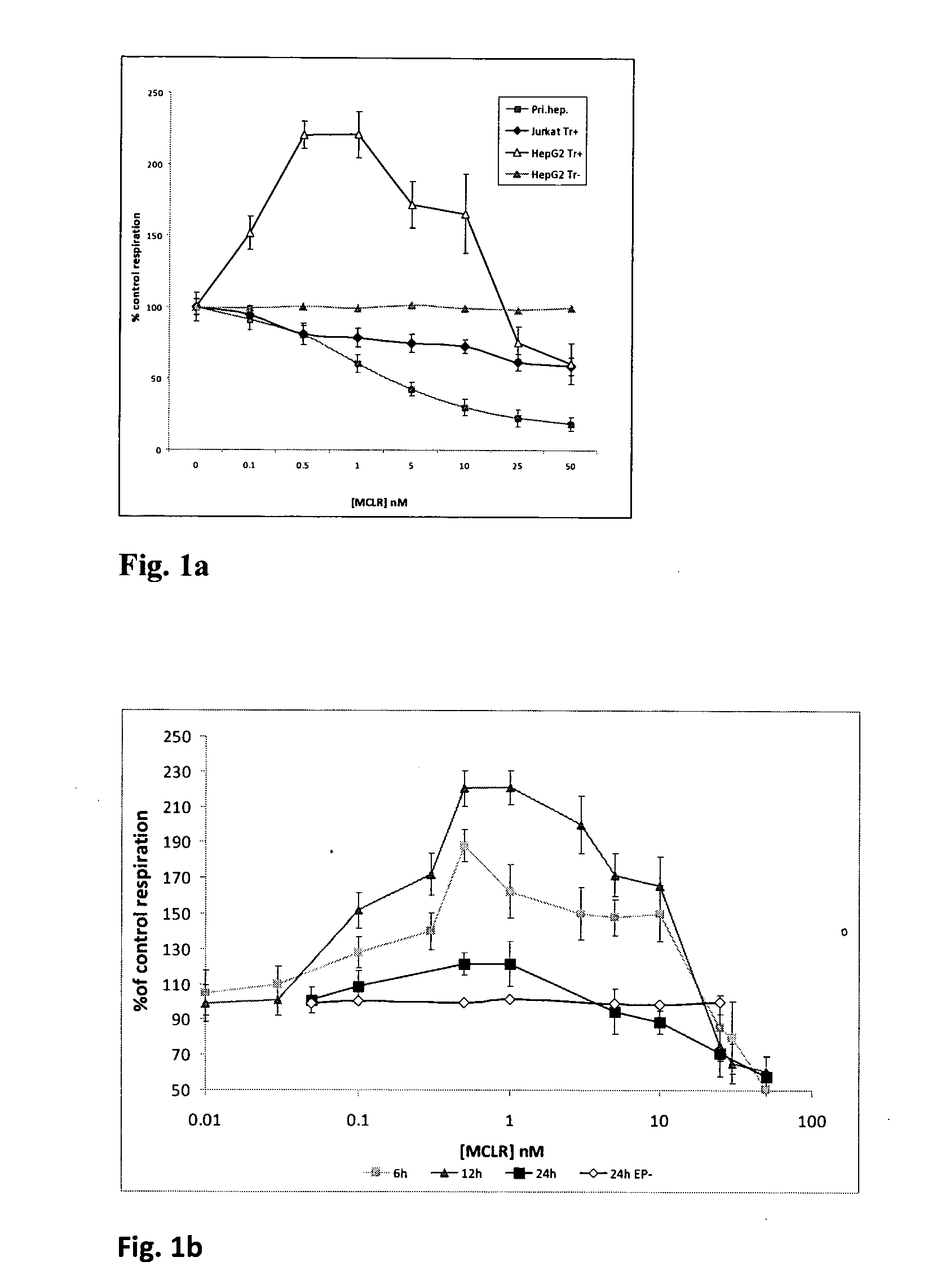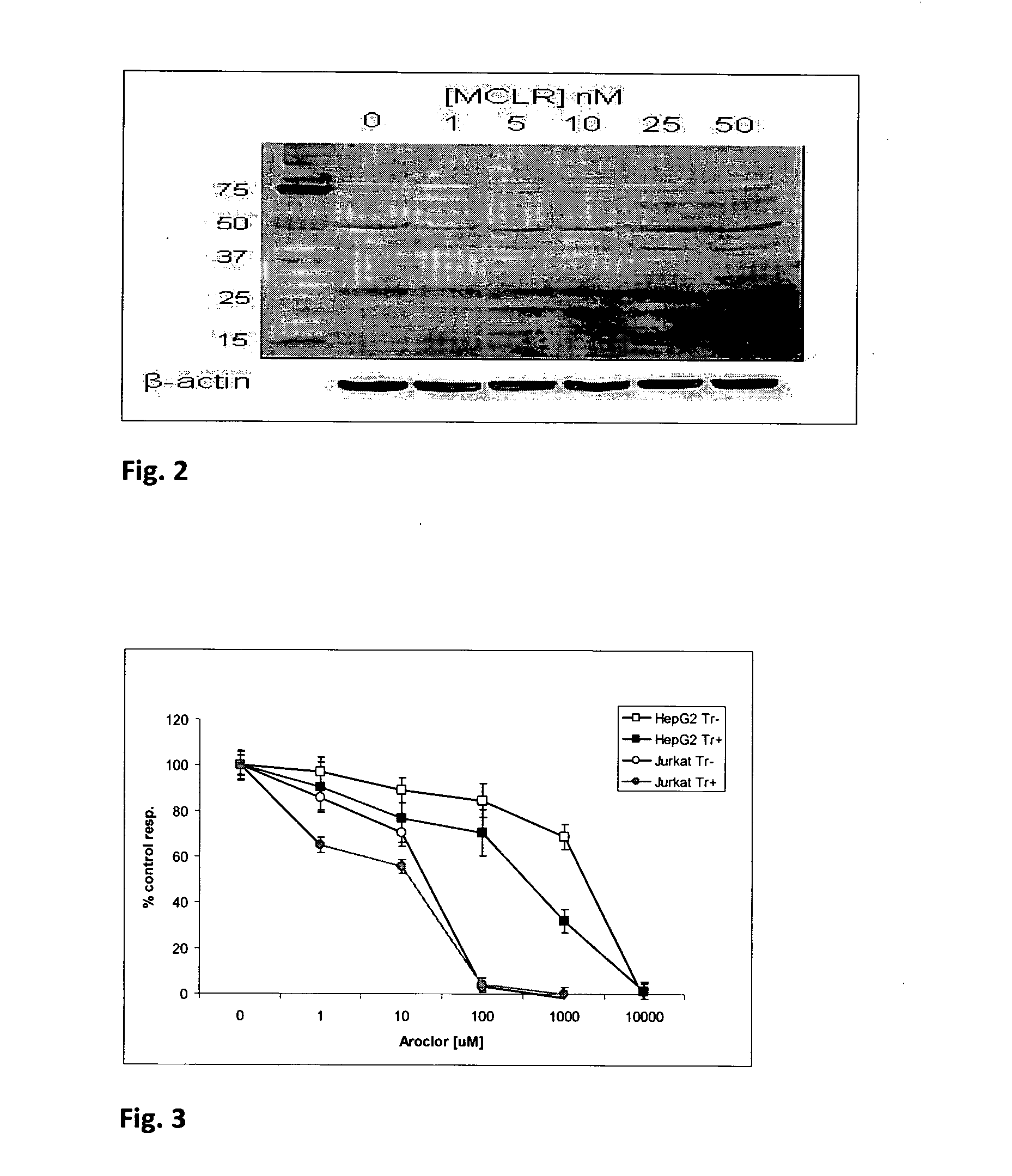Method of Toxicological Assessment
a toxicological and toxicological technology, applied in the direction of liquid/fluent solid measurement, biochemistry apparatus and processes, material testing goods, etc., can solve the problems of difficult application of toxicological data generated with these models to higher animals and humans, high sample throughput and ethical issues, and long techniques
- Summary
- Abstract
- Description
- Claims
- Application Information
AI Technical Summary
Benefits of technology
Problems solved by technology
Method used
Image
Examples
example 1
In Vitro Assessment of Toxicity of Microcystin-LR Using Primary Hepatocytes and Cultured Cells
[0050]Primary rat hepatocytes were isolated from Sprague-Dawley rats by the standard two-step collagenase perfusion method, seeded on collagen-coated 96 well plates in DMEM containing 1 g / L glucose and left for 3 h to adhere at 37oC in CO2 incubator. Microcystin-LR stock in ethanol was diluted in medium, added to the test wells at the specified final concentrations and the plate was incubated for further 24 h. Controls without MCLR were also included. After the exposure, the MitoXpress oxygen probe (Luxcel Biosciences) was added at 0.15 uM to each assay well, the wells were covered with 100 ul of oil, and the plate was read at 37° C. on a fluorescence plate reader (Genios Pro, Tecan) in kinetic mode with readings in each well taken every 1 min over 60-120 min. Time-resolved fluorescent measurements were done with the following settings: excitation / emission—380 / 650 nm, gain—90, delay time—30...
example 2
Elaboration of MC-LR Toxicity Revealed by the New Method
[0052]The experiments in Example 1 have revealed marked increases in oxygen consumption in HepG2 cells upon their exposure to MCLR in the presence of Endoporter. The time scale and shape of the response and changes in cellular function suggest direct action of MCLR on mitochondria. Although mitochondrial toxicity of microcystins has been reported (based on the studies with primary cells), such strong uncoupling effect was not known so far. This effect was subsequently confirmed by the analysis of O2 consumption by isolated rat liver mitochondria in the presence of MCLR (in this case without Endoporter). Indeed, an uncoupling effect of MCLR was also observed in glutamate / malate medium but not in the other media.
[0053]A number of other markers of cellular function were also investigated for their alterations in response to MCLR treatment of cells in the presence of transport reagent. Similar to the results of traditional assay wi...
example 3
The Assessment of Other Toxicants and Transporting Reagents in the New Method
[0054]A number of other transport reagents, toxicants, cell models and parameters of cellular function were examined, using the general assay format described in Example 1. Some representative data is shown in Table 1.
TABLE 1Effects of different toxicants on test cells, with and without transport reagents.CellularTransportParameterToxicantCell modelreagentAssessedObserved effectMCLRPrimaryNoneO2 consumptionIC50 = 2.74 nM ± 0.65hepatocytesHepG2NoneO2 consumptionNo effect at 10 μMEndoporterO2 consumptionStrong UncouplingJurkatNoneO2 consumptionNo effect at 10 μMEscort IIIO2 consumptionEC50 = 4.85 nM ± 1.19EndoporterO2 consumptionEC50 = 22.65 nM ± 2.89JurkatNoneATP contentNo effect at 10 μMEndoporterATP contentDose dependent decreaseArochlorJurkatNoneO2 consumptionEC50 = 15.9 uM ± 3.15(pesticide)EndoporterO2 consumptionEC50 = 9.88 uM ± 1.39HepG2NoneO2 consumptionEC50 = 1365 uM ± 90EndoporterO2 consumptionEC50 ...
PUM
 Login to view more
Login to view more Abstract
Description
Claims
Application Information
 Login to view more
Login to view more - R&D Engineer
- R&D Manager
- IP Professional
- Industry Leading Data Capabilities
- Powerful AI technology
- Patent DNA Extraction
Browse by: Latest US Patents, China's latest patents, Technical Efficacy Thesaurus, Application Domain, Technology Topic.
© 2024 PatSnap. All rights reserved.Legal|Privacy policy|Modern Slavery Act Transparency Statement|Sitemap


